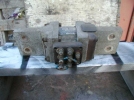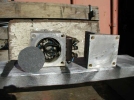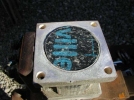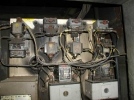| 06/13/2004 --- Returning to the electrical system, I decided to start with some problems I had noted earlier. The first issue was a very unusual situation with the BTR (Backwards Transition) Relay. This is a current operated device which is connected in series with the main generator. The main aluminum part of the relay is electrically connected to the positive side of the main generator and 6 of the little screw connections are terminals for relay contacts which are located inside the housing. I found that the low voltage circuit which connects to the screw terminals was shorted to the high voltage circuit of the housing. This not only created a dangerous shock hazard but caused some strange failure symptoms in the low voltage wiring. The second photo is the cover upon which there is a definite burn mark from the bare wire circled in photo 3. I made an insulator out of thick gasket material which should solve the problem. Click on any thumbnail
for a larger image. Use your browser's "back" button to get back
here.
|
 |
 |
 |
 |
 |
| As mentioned in the 05/31/04 update, there were
2 burned out coils in the transition circuit. This, in addition
to the problem with the BTS relay mentioned above. In the photo
below, the two relays concerned are the first and second from the left,
known as FSD1
and FSD2. They serve to control the operation of the transition
relays and without them operating properly, the locomotive would not
have been able to run much above 20 mph with a load. I was able
to come up with a couple of good coils out of my junk and the circuit
tests good now. The top 4 relays in this photo are known as delay
relays. There are 2 types. In the first, when the relay is
energized, an adjustable time period passes before the switch changes
position. When the relay de-energizes, the switch changes back
immediately. In the second, the relay energizes and the switch
changes position immediately. When the relay de-energizes, an
adjustable time period passes before the switch changes position
again.
Remember that this is 1950's technology and these relays would easily
be replaced with electronic timers today. --- Howard |
 |